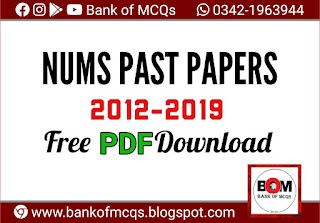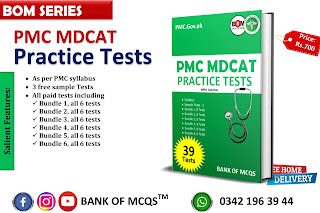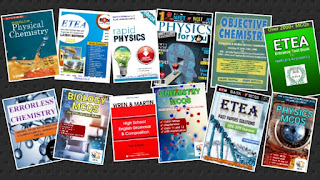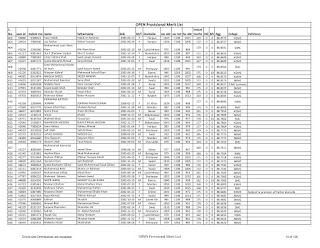Biology 12 Chap No.14 Respiration MCQs
|
1. |
|
|
|
2. |
How much oxygen molecules are transported by
the red blood cells as oxyhaemologbin? (a)
96% (b)
97% (c)
98% (d)
99% |
B |
|
3. |
……….
of oxygen is carried out by plasma (a)
2% (b) 3% (c)
5% (d) 6% |
B |
|
4. |
Maximum
oxygen carrying capacity of arterial blood at 100 mmHg PO, is: (a)
20ml/100ml of Blood (b)
19.4 ml/100ml of Blood © 5ml/100ml of Blood (d)
4.4 ml/100ml of Blood |
A |
|
5. |
Amount
of hemoglobin in 100ml of blood is: (a)
5 g (b) 10 g (
15 g (d) 20 g |
C |
|
6. |
I
gm hemoglobin can combine with: (a)
1.24 ml of O (b) 1.34 ml of O (c)
1.44 ml of O (d) 2.34 ml of O |
B |
|
7. |
Normal
value of oxygen in 100ml of arterial blood will be: (a)
19.4 ml O2 (b)
18.4 ml O2 (c)
17.4 ml O2 (d)
20.4 ml O2 |
A |
|
8. |
100
of venous blood will have oxygen at rest: (a)
19.4 ml O2 (b)
14.4 ml O2 (c)
20 ml O2 (d)
5 ml O2 |
B |
|
9. |
100 ml of blood will release oxygen to the
tissue at rest at a volume of: (a)
5 ml (b)
20 ml (c)
19.4 ml (d) 20.4 ml |
A |
|
10. |
During
exercise 100ml of blood will release oxygen to the active tissue at a volume
of: (a)
5ml (b) 10 ml (c)
15ml (d) 20ml |
C |
|
11. |
The
venous blood that leaves an active tissue has only oxygen: (a)
4.4 ml/100ml of Blood (b)
3.4ml/100ml of Blood (c)
19.4ml/100ml of Blood (d)
1.34ml/100ml of Blood |
A |
|
12. |
In
plasma 100ml of blood will have oxygen: (a)
0.29ml O (b) 0.39 ml O2 (c)
0.49 ml O (d) 0.59 ml O |
A |
|
13. |
In
plasma 100ml of venous blood will have oxygen: (a)
0.02 ml (b) 0.12 ml (c)
0.18 ml (d) 2.1 ml |
B |
|
14. |
100
of blood will carry oxygen in the dissolved
state in plasma: (a)
0.17ml (b) 0.27 ml (c)
0.37 ml (d) 0.47 ml |
A |
|
15. |
the
trachea of man, prevent it from: A series of C-shaped cartilage rings present (a)
Bending (b) Shorteding (c)
collapsing (d) Swelling |
C |
|
16. |
In
man the O2 is liberated from hemoglobin when the pressure in ml of Hg in
cells or tissues falls below (a)
80 of Hg (b) 60 of Hg (c)
70 of Hg (d) 50 of Hg |
D |
|
17. |
The
opening of the larynx is: (a)
Epiglottis (b) Larynx (c)
Trachea (d) Vocal cord |
A |
|
18. |
Under
resting conditions an adult human breath: (a)
10-13 Times Per Minute (b)
10-15 Times Per Minute (c)
15-20 Times Per Minute (d)
13 Times Per Minute |
C |
|
19. |
When
the chest wall is lowered and moves inward, and the diaphragm is raised, it
results in: (a)
Respiration (b) Expiration (c)
Inspiration d) Breathing |
B |
|
20. |
Breathing
rate in mammals is controlled by a centre situated in a part of the brain
called the (a)
Thalamus (b) Hypothalamus (c)
Medulla oblongata (d) Cerebellum |
C |
|
21. |
Respiration means: (a)
Intake of Oxygen (b)
Removal of Carbon Dioxide Only (C)
Use of Oxygen in Oxidation of Assimilated Food Resulting in Liberation of
Energy and CO2 (d)
All of these |
C |
|
22. |
How
many polypeptide chains are found in a myoglobin molecule? (a)
One (b)
Two (c)
Four (d)
Six |
A |
|
23. |
How
much air the lungs can hold when they are fully inflated? (a)
4 Litres (b) 5 Litres (C)
3.5 Litres (d) 1.5 Litre |
B |
|
24. |
Which
of these factors influence the respiratory centre? (a)
Water Vapour (b) CO: (c)
Both of these (d) None of these |
B |
|
25. |
BCG
vaccine is used for the prevention of: (a)
Emphysema (b)
Lung Cancer (e)
Tuberculosis (d) Pneumonia |
C |
|
26. |
Accumulation
of pus in the pleural cavity results in a condition known as: (a)
Empyema (b) Pleural
Effusion (c)
Hyponatemia (d) Asthma |
A |
|
27. |
Otitis
media is the inflammation of: (a)
Eye (b) Ear (c)
Nose (d) Throat |
B |
|
28. |
Number
of large sinuses is: (a)
Two (b)
Four (c)
One (d)
Ten |
A |
|
29. |
Hamburger's
phenomenon or chloride shift is associated with the transport of: (a)
Oxygen (b) Nitrogen (c)
CO2 (d)
All of these |
D |
|
30. |
Most
of the carbon dioxide is transported in (a)
Carboxyhemoglobin (b)
Oxyhaemoglobin (C)
Bicarbonate ions (d)
dissolved in Plasma |
A |
|
31. |
The
enzyme carbonic anhydrase is present in: (a)
White blood cells (b) Red Blood Cells (c)
Platelets (d) Lungs |
B |
|
32. |
How
much oxygen is released to the tissues by each 100ml of blood? (a)
20 ml (b) 5 ml (c)
16 ml (d)1.34 ml |
B |
|
33. |
Amount
of hemoglobin per 100 ml of blood is: (a)
10 gm (b) 15 gm (c)
100 gm (d) 60 gm |
B |
|
34. |
Bronchioles
have a diameter of: (a)
1 mm (b) 10 mm (c)
20 mm (d) 13 mm |
A |
|
35. |
Which
of the following has no cartilage? (a)
Trachea (b) Larynx (c)
Bronchi (d) Bronchioles |
D |
|
36. |
Thickness
of the alveolar walls is (a)
1 um (b) 0.1 um (0)
10 um (d) 2 um |
B |
|
37. |
Vocal
cords in males, as compared to females, are: (a)
Small in size (b)
Large in size (c)
Equal in size (d)
Females have no vocal cords |
B |
|
38. |
There
are three lobes in: (a)
Right Lung (b) Left Lung (C)
Both Lungs (d)
None of these |
A |
|
39. |
Lungs
are covered by membranes known as: (a)
Peritoneum (b) Pericardium (c)
Pleura (d)
Perimetrium |
C |
|
40. |
Tidal
volume is about: (a)
1.5 Litres (b) 5 Litres (c)
500ml (d) 3.5 Litres |
C |
|
41. |
Breathing
is controlled by: (a)
Cerebrum (b) Medulla
oblongata (c)
Cerebellum (d) Thalamus |
B |
|
42. |
Surfactant
is secreted by the cells of: (a)
Bronchi (b) Lungs (c)
Alveoli (d) All of
these |
C |
|
43. |
Ventral
portion of the breathing centre stimulates: (a) Inspiration (b) Expiration (c)
Both of these (d) None of these |
A |
|
44. |
Our
normal oxygen intake per minute amounts to: (a)
20ml (b) 250ml (c)
100ml (d) 300ml |
B |
|
45. |
In
human, inspiration is: (a)
An Active Process (b) A Passive Process (c)
Does Not Occur (d) None of these |
A |
|
46. |
If
air is introduced in the pleural cavity, the lung collapses, a situation
known as: (a)
Sinusitis (b) Emphysema (c)
Pneumothorax (d) Otitis Media |
c |
|
47. |
Rate
of oxygen consumption is estimated by using: (a)
Thermometer (b) Stethoscope (c)
Spirometer (d)
Sphygmomanometer |
C |
|
48. |
The
wall of trachea (windpipe) and bronchi of man is furnished with a series of
incomplete: (a)
Cartilaginous Plates (b)
Chitinous Rings (c)
Cartilaginous Rings (d)
Muscular Rings |
C |
|
49. |
What
does not happen during inspiration in man? (a)
Intercostal Muscles Contract (b)
Ribs are Elevated (C)
Diaphragm Becomes Dome Shaped (d)
Ribs Move Forward |
C |
|
50. |
The
lateral walls of the chest cavity of man are composed of the: (a)
Ribs (b)
Intercostals Muscles (e)
Ribs and Intercostals Muscles (d)
Ribs, Intercostals Muscles and Diaphragm |
C |
|
51. |
When
the human blood leaves the capillary bed of the tissue, most of the carbon
dioxide is the form of: (a)
Carbonic Acid (b)
Bicarbonate ions (c)
Carboxylic Acid (d) None
of them |
B |
|
52. |
Which
sequence of organs is correct in air passageway of man? (a)
Nasal cavities, larynx, pharynx, trachea bronchi (b)
Nasal cavities, pharynx, trachea, larynx, bronchi (C)
Nasal cavities, pharynx, larynx, bronchi. trachea (d)
Nasal cavities, pharynx, larynx, trachea, bronchi |
D |
|
53. |
Which
part of the air passage way possesses cartilage plates in its walls? (a)
Bronchioles (b)
Distal Region of Bronchi (c)
Proximal Region of Bronchi (d)
Trachea |
D |
|
54. |
Human
lungs are spongy due to the presence of millions of: (a)
Bronchi (b)
Alveoli (c)
Bronchioles (d)
Trachea |
B |
|
55. |
Which
event is not associated with the activity of expiration? (a)
Contraction of Diaphragm (b)
More dome like shape of diaphragm (c)
Backward and downward movement of rib Cage (d)
Relaxation of Intercostal Muscles |
A |
|
56. |
Oxygen
carrying capacity of blood does not depend on: (a)
Partial pressure of CO (b)
Partial pressure of O (c)
Height from sea level (d)
Quantity of blood |
A |
|
57. |
When
haemoglobin of the blood is fully saturated with oxygen, the 100cc of blood
contains: (a)
15cc of Oxygen (b) 20cc
of Oxygen (c)
25cc of Oxygen (d) 10cc
of Oxygen |
B |
|
58. |
If
the average breathing rate is 15 breaths per minute and the tidal volume is
0.5 litre, the ventilation rate will be: (a)
1.5 Litres min (b)
7.5 Litres min (c)
0.75 Litres min (d) 5
Litres min |
B |








Comments
Post a Comment